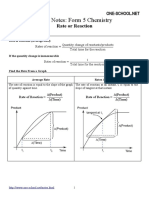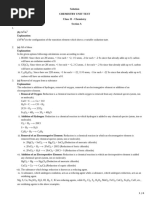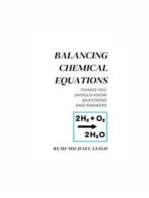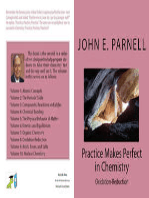Chapter 5 Answers Practice Examples: Reduction
Uploaded by
Emre Enes EdizChapter 5 Answers Practice Examples: Reduction
Uploaded by
Emre Enes EdizChapter 5 Answers
Practice Examples
1a. 0.540 M Cl−
1b. (a) 7.9 × 10-5 M F- ; (b) 3.1 kg CaF2
2a. (a) Al3+ ( aq ) + 3 OH − ( aq ) → Al ( OH )3 ( s )
(b) No reaction occurs.
(c) Pb 2+ ( aq ) + 2 I − ( aq ) → PbI 2 ( s )
(a) Al3+ ( aq ) + PO 4 ( aq ) → AlPO 4 ( s )
3−
2b.
(b) Ba 2+ ( aq ) + SO 4 ( aq ) → BaSO 4 ( s )
2−
(c) Pb 2+ ( aq ) + CO3 ( aq ) → PbCO3 ( s )
2−
3a. The acid and base react to form a salt solution of ammonium propionate.
NH 3 ( aq ) + HC3 H 5 O 2 ( aq ) → NH 4 ( aq ) + C3 H 5 O 2 ( aq )
+ −
3b. CaCO3 ( s ) + 2 HC2 H 3 O 2 ( aq ) → CO 2 ( g ) + H 2 O ( l ) + Ca 2+ ( aq ) + 2 C 2 H 3 O 2 ( aq )
−
4a. (a) It is not an oxidation–reduction reaction; (b) This is an oxidation–reduction reaction.
4b. Vanadium is oxidized, manganese is reduced.
5a. Oxidation : {Al ( s ) → Al ( aq ) + 3 e } × 2
3+ −
Reduction: {2 H ( aq ) + 2 e → H ( g )} × 3
+ −
2
Net equation : 2 Al ( s ) + 6 H + ( aq ) → 2 Al3+ ( aq ) + 3 H 2 ( g )
5b. Oxidation : 2 Br − ( aq ) → Br2 ( l ) + 2 e −
Reduction: Cl2 ( g ) + 2 e − → 2 Cl− ( aq )
Net equation : 2 Br − ( aq ) + Cl2 ( g ) → Br2 ( l ) + 2 Cl− ( aq )
6a. MnO 4 − ( aq ) + 8 H + ( aq ) + 5 Fe 2+ ( aq ) → Mn 2+ ( aq ) + 4 H 2 O(l) + 5 Fe3+ ( aq )
6b. 3 UO 2+ ( aq ) + Cr2 O7 ( aq ) + 8 H + ( aq ) → 3 UO2 2+ ( aq ) + 2 Cr 3+ ( aq ) + 4 H 2O(l)
2−
7a. S ( s ) + 2 OH − ( aq ) + 2 OCl− ( aq ) → SO3 ( aq ) + H 2O(l) + 2 Cl − ( aq )
2−
Copyright © 2011 Pearson Canada Inc. 1
7b. 2 MnO 4 − ( aq ) + 3SO32− ( aq ) + H 2O(l) → 2 MnO 2 ( s ) + 3SO 4 2− ( aq ) + 2 OH − ( aq )
8a. Since the oxidation state of H is 0 in H2 (g) and is +1 in both NH3(g) and H2O(g), hydrogen
is oxidized. A substance that is oxidized is called a reducing agent. The oxidation state of the
element N decreases during this reaction, meaning that NO2 (g) is reduced. The substance that is
reduced is called the oxidizing agent.
8b. Au has been oxidized and, thus, Au(s) (oxidization state = 0), is the reducing agent. O has
been reduced and thus, O2(g) (oxidation state = 0) is the oxidizing agent.
9a. 0.1019 M
9b. 0.130 M
10a. 65.4% Fe
10b. 0.03129 M
Integrative Example
A. 49.89%
B. 1.32%
Exercises
1a. Weak electrolyte
1b. Strong electrolyte
1c. Strong electrolyte
1d. Nonelectrolyte.
1e. Strong electrolyte
3. HCl is practically 100% dissociated into ions. The apparatus should light up brightly. A
solution of both HCl and HC2H3O2 will yield similar results.
5a. Barium bromide: strong electrolyte
5b. Propionic acid: weak electrolyte
5c. Ammonia: weak electrolyte
7a. 0.238 M K +
7b. 0.334 M NO3−
7c. 0.166 M Al3+
Copyright © 2011 Pearson Canada Inc. 2
7d. 0.627 M Na +
9. 3.04 ×10-3 M OH -
11a. 3.54 ×10−4 M Ca 2+
11b. 8.39 ×10−3 M K +
11c. 3.44 ×10−3 M Zn 2+
13. The solution containing 8.1 mg K+ per mL gives the largest K+ of the three solutions.
15. 4.3 ×102 mg MgI 2
17. 0.732 M
19a. Pb 2+ ( aq ) + 2 Br − ( aq ) → PbBr2 ( s )
19b. No reaction occurs (all are spectator ions).
19c. Fe3+ ( aq ) + 3 OH − ( aq ) → Fe ( OH )3 ( s )
21a. No reaction occurs.
21b. Cu 2+ ( aq ) + CO32− ( aq ) → CuCO3 ( s )
21c. 3Cu 2+ ( aq ) + 2 PO 43− ( aq ) → Cu 3 ( PO 4 )2 ( s )
23a. Add K 2 SO 4 ( aq ) ; BaSO 4 ( s ) will form and MgSO4 will not precipitate.
23b. H 2 O ( l ) ; Na 2 CO3 ( s ) dissolves, but MgCO3 (s) will not dissolve (appreciably).
23c. Add KCl(aq); AgCl(s) will form, while Cu(NO3)2 (s) will dissolve.
25a. Sr ( NO3 )2 ( aq ) + K 2SO 4 ( aq ) : Sr 2+ ( aq ) + SO 4 2− ( aq ) → SrSO 4 ( s )
25b. Mg ( NO3 )2 ( aq ) + NaOH ( aq ) : Mg 2+ ( aq ) + 2 OH − ( aq ) → Mg ( OH )2 ( s )
25c. BaCl2 ( aq ) + K 2SO 4 ( aq ) : Ba 2+ (aq) + SO 4 2− (aq) → BaSO 4 (s)
27a. OH − ( aq ) + HC2 H 3 O 2 ( aq ) → H 2 O ( l ) + C 2 H 3 O 2 ( aq )
−
27b. No reaction occurs. This is the physical mixing of two acids.
27c. FeS ( s ) + 2 H + ( aq ) → H 2 S ( g ) + Fe 2+ ( aq )
Copyright © 2011 Pearson Canada Inc. 3
27d. HCO3
−
( aq ) + H + ( aq ) → "H 2 CO3 ( aq ) " → H 2 O ( l ) + CO 2 ( g )
27e. Mg ( s ) + 2 H + ( aq ) → Mg 2+ ( aq ) + H 2 ( g )
As a salt: NaHSO 4 ( aq ) → Na + ( aq ) + HSO 4 ( aq )
−
29.
As an acid: HSO 4
−
( aq ) + OH − ( aq ) → H 2 O ( l ) + SO 4 ( aq )
2−
31. Use (b), NH3(aq). NH3 affords the OH- ions necessary to form Mg(OH)2(s).
33a. The O.S. of H is +1 , that of O is −2 , that of C is +4 , and that of Mg is +2 on each side of
this equation. This is not a redox equation.
33b. The O.S. of Cl is 0 on the left and −1 on the right side of this equation. The O.S. of Br is
−1 on the left and 0 on the right side of this equation. This is a redox reaction.
33c. The O.S. of Ag is 0 on the left and +1 on the right side of this equation. The O.S. of N is
+5 on the left and +4 on the right side of this equation. This is a redox reaction.
33d. On both sides of the equation the O.S. of O is −2 , that of Ag is +1 , and that of Cr is +6 .
Thus, this is not a redox equation.
35a. 2SO3
2−
( aq ) + 6 H + ( aq ) + 4 e − → S2 O3
2−
( aq ) + 3 H 2 O(l)
35b. 2 NO3 ( aq ) +10 H + ( aq ) + 8 e − → N 2 O ( g ) + 5 H 2 O ( l )
−
35c. Al ( s ) + 4 OH − ( aq ) → Al ( OH )4 ( aq ) + 3
−
e−
37a. 10 I − ( aq ) + 2 MnO 4 − ( aq ) +16 H + ( aq ) → 5 I 2 ( s ) + 2 Mn 2+ ( aq ) + 8 H 2O ( l )
37b. 3 N 2 H 4 ( l ) + 2 BrO3 ( aq ) → 3 N 2 ( g ) + 2 Br − ( aq ) + 6 H 2 O ( l )
−
37c. Fe 2+ ( aq ) + VO 4 ( aq ) + 6 H + ( aq ) → Fe3+ ( aq ) + VO 2+ ( aq ) + 3 H 2 O ( l )
3−
37d. 3 UO 2+ ( aq ) + 2 NO3− ( aq ) + 2 H + ( aq ) → 3 UO 2 2+ ( aq ) + 2 NO ( g ) + H 2 O ( l )
39a. 2 MnO 2 ( s ) + ClO3 ( aq ) + 2 OH − ( aq ) → 2MnO 4 ( aq ) + Cl− ( aq ) + H 2 O(l)
− −
39b. 2 Fe ( OH )3 ( s ) + 3 OCl− ( aq ) + 4 OH − ( aq ) → 2FeO 4 2− ( aq ) + 3 Cl − ( aq ) + 5 H 2 O(l)
39c. 6 ClO 2 (aq) + 6 OH − ( aq ) → 5ClO3 ( aq ) + Cl− ( aq ) + 3 H 2 O
−
39d. 3 Ag(s) + CrO42- + 4 H2O(l) 3 Ag+(aq) + Cr(OH)3(s) + 5 OH-
Copyright © 2011 Pearson Canada Inc. 4
41a. 3 Cl2 ( g ) + 6 OH − ( aq ) → 5 Cl− ( aq ) + ClO3 ( aq ) + 3 H 2 O(l)
−
41b. 2 S2 O 4
2−
( aq ) + H 2 O(l) → 2 HSO3 ( aq ) + S2 O3
− 2−
( aq )
43a. 5 NO 2 ( aq ) + 2 MnO 4 ( aq ) + 6 H + ( aq ) → 5 NO3 ( aq ) + 2 Mn 2+ ( aq ) + 3 H 2O ( l )
− − −
43b. 3 Mn2+ (aq) + 2 MnO4- (aq) + 4 OH- (aq) → 5 MnO2 (s) + 2 H2O (l)
43c. Cr2 O7 2− ( aq ) + 8 H + ( aq ) + 3 C2 H 5 OH → 2 Cr 3+ ( aq ) + 7 H 2 O ( l ) + 3 CH 3 CHO
45a. CH4(g) + 4 NO(g) → 2 N2(g) + CO2(g) + 2 H2O(g)
45b. 16 H2S(g) + 8 SO2(g) → 3 S8(s) + 16 H2O(g)
45c. 10 NH3(g) +3 Cl2O(g) → 6 NH4Cl(s) + 2 N2(g) + 3 H2O(l)
47a. SO3
2−
( aq ) is the reducing agent; MnO 4
−
( aq ) is the oxidizing agent.
47b. H 2 ( g ) is the reducing agent; NO 2 ( g ) is the oxidizing agent.
4−
47c. Fe ( CN )6 ( aq ) is the reducing agent; H 2 O 2 ( aq ) is the oxidizing agent.
49. 13.3 mL NaOH ( aq ) soln
51. 3.546 mL KOH solution
53. 0.1230 M NaOH
55. 0.077 M NaOH
57. Acidic
59. 34 mL base
61. Answer is (d).
63. 1.968 ×10-2 M
65. 53.23% Fe
67. 37.0 g Na 2 C2 O 4
Integrative and Advanced Exercises
2−
71. 3 Ca 2 + (aq) + 2 HPO 4 (aq)
→ Ca 3 (PO 4 ) 2 (s) + 2 H + (aq)
74. 108 ppm Mg
Copyright © 2011 Pearson Canada Inc. 5
75. 0.0874 L
80a. 4 FeS2(s) + 15 O2(g) + 2 H2O(l) → 4 Fe3+(aq) + 8 SO42−(aq) + 4 H+(aq)
80b. 23.4 g CaCO3
83. 44.6 g Cl2
85. 5.0 ×102 g ClO 2 (g)
88a. 45.9 g
88b. 1.00 L
89. % Mg(OH)2 = 21.6; %Al(OH)3 = 78.4.
91. 0.4346 %
93a. CaO(s) + H2O(l) → Ca2+(aq) + 2 OH−(aq)
H2PO4−(aq) + 2 OH−(aq) → PO43−(aq) + 2 H2O(l)
HPO4−(aq) + OH−(aq) → PO43−(aq) + H2O(l)
5 Ca2+(aq) + 3 PO43−(aq) + OH−(aq) → Ca5(PO4)3OH(s)
93b. 0.302 kg
Feature Problems
94. x = 1.03
95. 91.0% MnO 2
97. Before the breath test: 8×10-4 M; After the breath test 3 × 10−4 mol/L.
Self-Assessment Exercises
102. The answer is (b).
103. The answer is (d).
104. The answer is (c).
105. The answer is (a).
106. 2I- + Pb 2+ → PbI 2 (s)
107. CO 23 − + 2H + → H 2 O (l) + CO 2 (g)
108a. 3 Zn 2+ + PO34− → Zn 3 (PO 4 ) 2 (s)
Copyright © 2011 Pearson Canada Inc. 6
108b. Cu 2+ + 2 OH − → Cu(OH) 2 (s)
108c. Ni 2+ + CO32− → NiCO3 (s)
109a. Species oxidized: N in NO
109b. Species reduced: O2
109c. Oxidizing agent: O2
109d. Reducing agent: NO
109e. Gains electrons: O2
109f. Loses electrons: NO
110. The answer is (b).
111. The answer is (d).
112. The answer is (a).
113a. False
113b. True
113c. False
113d. False
113e. True
114a. No
114b. Yes
114c. Yes
114d. No
Copyright © 2011 Pearson Canada Inc. 7
You might also like
- Learning Area Grade Level Quarter Date: TLE-Electrical Installation and Maintenance (EIM NCII) 9 FourthNo ratings yetLearning Area Grade Level Quarter Date: TLE-Electrical Installation and Maintenance (EIM NCII) 9 Fourth6 pages
- Unit 16 Electrochemistry Revision AnswersNo ratings yetUnit 16 Electrochemistry Revision Answers16 pages
- Unit 16 Electrochemistry Revision AnswersNo ratings yetUnit 16 Electrochemistry Revision Answers16 pages
- Chemical Equations: Preparation For College Chemistry Columbia University Department of ChemistryNo ratings yetChemical Equations: Preparation For College Chemistry Columbia University Department of Chemistry31 pages
- Prepared by Dr. Tony Jacob (Resource Page) : Redox Reactions Occur When There Is A Change in Oxidation NumberNo ratings yetPrepared by Dr. Tony Jacob (Resource Page) : Redox Reactions Occur When There Is A Change in Oxidation Number4 pages
- Short Notes: Form 5 Chemistry: Rate or ReactionNo ratings yetShort Notes: Form 5 Chemistry: Rate or Reaction20 pages
- Short Notes: Form 5 Chemistry: Rate or ReactionNo ratings yetShort Notes: Form 5 Chemistry: Rate or Reaction20 pages
- chem_reactions-practice-problems_2013-03-01_6900 answer key -QBLC checked correctNo ratings yetchem_reactions-practice-problems_2013-03-01_6900 answer key -QBLC checked correct10 pages
- XI NEET 16 Answer Key DPP 3 4 2 AcademyNo ratings yetXI NEET 16 Answer Key DPP 3 4 2 Academy10 pages
- Exam Questions Redox and Groups 2 and 7 MsNo ratings yetExam Questions Redox and Groups 2 and 7 Ms11 pages
- 2.04 - 2.06 Redox Reactions, Halogens and Alkali Earth Metals MSNo ratings yet2.04 - 2.06 Redox Reactions, Halogens and Alkali Earth Metals MS28 pages
- Electrochemistry: Review of Oxidation Reduction ReactionsNo ratings yetElectrochemistry: Review of Oxidation Reduction Reactions48 pages
- Olympiad Chemistry Reaction Questions_redox Reactions_January 14_2025No ratings yetOlympiad Chemistry Reaction Questions_redox Reactions_January 14_20256 pages
- dawson collage chemistry 2010 final exam answerNo ratings yetdawson collage chemistry 2010 final exam answer19 pages
- Class X Chemistry: Icse Question Paper (2016)No ratings yetClass X Chemistry: Icse Question Paper (2016)8 pages
- Ex. - C4 - Chemical Reactions - SolutionNo ratings yetEx. - C4 - Chemical Reactions - Solution20 pages
- Introduction To Reactions in Aqueous Solutions Practice ExamplesNo ratings yetIntroduction To Reactions in Aqueous Solutions Practice Examples25 pages
- Balancing Chemical Equations: Things You Should Know (Questions and Answers)From EverandBalancing Chemical Equations: Things You Should Know (Questions and Answers)No ratings yet
- Practice Makes Perfect in Chemistry: Oxidation-Reduction with AnswersFrom EverandPractice Makes Perfect in Chemistry: Oxidation-Reduction with AnswersNo ratings yet
- MEE342 - Test 1 and 2 - Suggested SolutionsNo ratings yetMEE342 - Test 1 and 2 - Suggested Solutions3 pages
- Post Weld Heat Treatment Procedure: Doc No: STS/QAC/SOP/12No ratings yetPost Weld Heat Treatment Procedure: Doc No: STS/QAC/SOP/1218 pages
- 2200 Smopme10 B01 00004 002 - 01 - CommentedNo ratings yet2200 Smopme10 B01 00004 002 - 01 - Commented1 page
- Technical Service Data Sheet: Cupratech Ac 382No ratings yetTechnical Service Data Sheet: Cupratech Ac 3825 pages
- Me785 - Machining and Forming - Lab ManualNo ratings yetMe785 - Machining and Forming - Lab Manual28 pages
- CMPM Reviewer Quiz 1: It Means The Demolition of A Structure Done With Some Equipment Without The Use of Any ExplosiveNo ratings yetCMPM Reviewer Quiz 1: It Means The Demolition of A Structure Done With Some Equipment Without The Use of Any Explosive3 pages
- EN 288-1 General Rules For Fusion WeldingNo ratings yetEN 288-1 General Rules For Fusion Welding15 pages
- Section7 - Suction Strainers and Magnetic Suction SeparatorsNo ratings yetSection7 - Suction Strainers and Magnetic Suction Separators6 pages
- Tianjin Tuozhiming Lab Equipment Co., LTD.: Add: Acids Purification SystemNo ratings yetTianjin Tuozhiming Lab Equipment Co., LTD.: Add: Acids Purification System16 pages
- Quick Sheet: API 594 Cast Steel Swing Check ValveNo ratings yetQuick Sheet: API 594 Cast Steel Swing Check Valve3 pages
- Learning Area Grade Level Quarter Date: TLE-Electrical Installation and Maintenance (EIM NCII) 9 FourthLearning Area Grade Level Quarter Date: TLE-Electrical Installation and Maintenance (EIM NCII) 9 Fourth
- Chemical Equations: Preparation For College Chemistry Columbia University Department of ChemistryChemical Equations: Preparation For College Chemistry Columbia University Department of Chemistry
- Prepared by Dr. Tony Jacob (Resource Page) : Redox Reactions Occur When There Is A Change in Oxidation NumberPrepared by Dr. Tony Jacob (Resource Page) : Redox Reactions Occur When There Is A Change in Oxidation Number
- chem_reactions-practice-problems_2013-03-01_6900 answer key -QBLC checked correctchem_reactions-practice-problems_2013-03-01_6900 answer key -QBLC checked correct
- 2.04 - 2.06 Redox Reactions, Halogens and Alkali Earth Metals MS2.04 - 2.06 Redox Reactions, Halogens and Alkali Earth Metals MS
- Electrochemistry: Review of Oxidation Reduction ReactionsElectrochemistry: Review of Oxidation Reduction Reactions
- Olympiad Chemistry Reaction Questions_redox Reactions_January 14_2025Olympiad Chemistry Reaction Questions_redox Reactions_January 14_2025
- Introduction To Reactions in Aqueous Solutions Practice ExamplesIntroduction To Reactions in Aqueous Solutions Practice Examples
- Balancing Chemical Equations: Things You Should Know (Questions and Answers)From EverandBalancing Chemical Equations: Things You Should Know (Questions and Answers)
- Practice Makes Perfect in Chemistry: Oxidation-ReductionFrom EverandPractice Makes Perfect in Chemistry: Oxidation-Reduction
- Practice Makes Perfect in Chemistry: Oxidation-Reduction with AnswersFrom EverandPractice Makes Perfect in Chemistry: Oxidation-Reduction with Answers
- Post Weld Heat Treatment Procedure: Doc No: STS/QAC/SOP/12Post Weld Heat Treatment Procedure: Doc No: STS/QAC/SOP/12
- CMPM Reviewer Quiz 1: It Means The Demolition of A Structure Done With Some Equipment Without The Use of Any ExplosiveCMPM Reviewer Quiz 1: It Means The Demolition of A Structure Done With Some Equipment Without The Use of Any Explosive
- Section7 - Suction Strainers and Magnetic Suction SeparatorsSection7 - Suction Strainers and Magnetic Suction Separators
- Tianjin Tuozhiming Lab Equipment Co., LTD.: Add: Acids Purification SystemTianjin Tuozhiming Lab Equipment Co., LTD.: Add: Acids Purification System

























































































